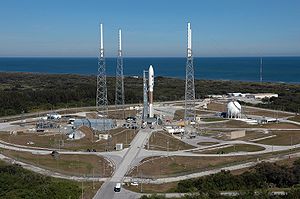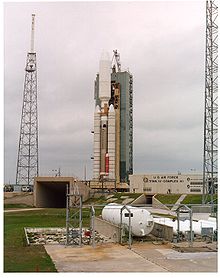- Cape Canaveral Air Force Station Space Launch Complex 41
-
Space Launch Complex 41 
An aerial view of SLC-41. The Atlas V on the pad is the one used to launch New Horizons to Pluto.Launch site Cape Canaveral Air Force Station Location 28°35'N
80°34'58"WShort name SLC-41 Operator US Air Force Total launches 50 Launch pad(s) 1 Minimum / maximum
orbital inclination28° - 57° Launch history Status Active First launch 21 December 1965
Titan IIIC / LES-3/4Last launch 5 August 2011
Atlas V / JunoAssociated rockets Titan III
Titan IV
Atlas V (current)Cape Canaveral Air Force Station Space Launch Complex 41 (SLC-41), previously Launch Complex 41 (LC-41), is an active launch site at the north end of Cape Canaveral, Florida.[1][2] The site is currently used by United Launch Alliance for Atlas V launches. Previously, it had been used by the Air Force, for Titan III and Titan IV launches.
Contents
Titan III
The Titan III launch facilities at CCAFS were built as part of an Integrate-Transfer-Launch approach intended to enable a rapid launch rate. Titan vehicles were assembled and integrated with their payloads off-pad and then transported by rail to one of the two pads. The Titan III facilities included both LC-40 and LC-41, assembly buildings including the Vertical Integration Building, and the first rail line at the Cape.[3] The facilities were completed in 1964 and the first launch from LC-41 was of a Titan IIIC, carrying four separate payloads, on December 21, 1965.
LC-41 was also the pad used for the maiden flight of the Titan IV. The last Titan launch was on April 9, 1999, when a Titan IVB launched the USA 142 early warning satellite. This launch resulted in a failure, after the IUS upper stage failed to separate, leaving the payload stranded in a useless GTO orbit.
Atlas V
After the last Titan launch the complex was renovated, and since 2002 LC-41 has been used by ULA for Atlas V launches. The maiden flight of Atlas V launched from LC-41 on August 21, 2002. The Atlas V booster lifted Hot Bird 6, a Eutelsat geostationary communications spacecraft built around a Spacebus 3000B3 bus.
Atlas V rockets are assembled vertically on a mobile launch platform in the Vertical Integration Facility, located to the South of the pad. The platform is transported to the launch pad on rails, around a day before launch.
Payloads
In addition to satellites, Titan vehicles launched several probes from LC-41 in the 1970s, including the Helios probes to study the Sun, the Viking probes to Mars, and the Voyager planetary flyby and deep space probes. More recent probes have also been launched from LC-41 using the Atlas V: the Mars Reconnaissance Orbiter in December 2004, the New Horizons spacecraft to Pluto in January 2006, Juno mission to Jupiter in August 2011[4], and Mars Science Laboratory to Mars scheduled for November 2011[5].
See also
References
- ^ McDowell, Jonathan (1998-02-22). "Issue 350". Jonathan's Space Report. Jonathan's Space Page. http://planet4589.org/space/jsr/back/news.350. Retrieved 2009-07-09.
- ^ USAF Supports NASA's Dual Lunar Exploratory Missions
- ^ Roy McCullough (September 2001). "Missiles at the Cape". US Army Corps of Engineers. http://handle.dtic.mil/100.2/ADA399207.
- ^ 45th Space Wing Supports Successful Atlas V Juno Launch
- ^ NASA Offers Media Access To Mars-Bound Rover On Aug. 12
External links
Coordinates: 28°35′00″N 80°34′59″W / 28.583457°N 80.583°W
Cape Canaveral and Merritt Island launch sites Atlantic Missile Range drop zone • Grand Turk Island drop zone • Mobile Launch Area • SLBM Launch Area • Patrick AFB • Shuttle Landing Facility • Cape Canaveral AFS Skid StripCategories:- Buildings and structures in Brevard County, Florida
- Cape Canaveral Air Force Station
Wikimedia Foundation. 2010.

